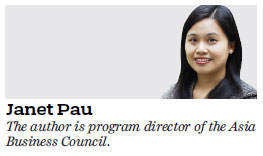Hong Kong can make itself a role model in preparing for pandemics
Updated: 2019-04-30 07:35
By Janet Pau(HK Edition)
|
|||||||
The current measles outbreak affecting Hong Kong airport workers and showing signs of spreading illustrates the unique vulnerability of Hong Kong as a densely populated city and an international travel hub for both humans and germs. The potential of old diseases popping up in new places and the emergence of new diseases that pose a pandemic risk will be intensified as people are packed in even closer quarters combined with hotter, wetter climate.
In the coming decades, Hong Kong will have to grapple with challenges from the nexus of public health and climate change. Warming temperatures and increased precipitation are likely to worsen the spread of infectious diseases that are vector-borne, by hosts such as mosquitoes and ticks. Climate change also accelerates the migration and dislocation of both humans and animals, exacerbating disease formation and spread. At the same time, continued urban sprawl means humans are encroaching upon animal habitats. This mixing of animals and humans creates the risk of zoonotic diseases, meaning viruses, bacteria, and parasites originating in animals that jump to humans. The measles virus was initially a zoonotic disease emerging from the rinderpest (German for cattle plague) virus, which evolved to infect humans around the 11th and 12th centuries. Rinderpest was mostly eradicated in the 1990s through large-scale vaccination.
The spread of zoonotic diseases of known nature, including avian and swine influenza, has already presented serious challenges for Hong Kong. Moreover, Hong Kong also risks exposure to imported infectious diseases of unknown origins, given its importance as a hub for international travel and cross-border livestock trade. World Health Organization scientists in March last year warned about Disease X - their name for an as-yet-unknown disease, possibly zoonotic in nature, which could become the next pandemic. SARS (severe acute respiratory syndrome) could well be regarded as the Disease X of the aughts, when a previously unknown virus that originated in bats was passed to civet cats, then to humans. Spreading through the air or through contact with infected droplets, SARS infected more than 8,000 people and killed nearly 800 worldwide during the 2003 outbreak. Bad as it was, scientists fear that something worse is on the way. The World Health Organization, the World Economic Forum and the Gates Foundation have all issued recent warnings about the lack of preparedness for pandemic scenarios.

Influenza outbreaks in Asia have already become more frequent. A number of research studies have found that certain influenza strains can survive in warmer temperatures, leading to longer flu seasons. Scientists at Harvard University and Columbia University suggest that La Nina conditions (warm currents moving northward) may alter the migratory patterns of birds and contribute to the jumbling and creation of novel pandemic strains that eventually infect humans.
Despite a relatively strong public health infrastructure and the experience of responding to SARS and other influenza outbreaks, Hong Kong, as a hot spot for pandemic risks, needs better preparedness and detection. Public-sector investments tend to favor low-risk and cost-effective solutions, notably vaccines. But, as the measles outbreak illustrates, when vaccine hesitancy is combined with diseases of a highly contagious nature, a multipronged strategy is needed.
The private sector may have the opportunity to invest in disruptive technological innovations to combat pandemics. The opportunities are three-fold. First, investments in technologies improve preparedness and detection saves money spent in direct healthcare costs as a result of disease outbreaks. Artificial intelligence is already being used to disrupt the conventional process of disease-trend forecasting. In Penang, Malaysia, a US company called AIME - an acronym that stands for "artificial intelligence for medical epidemiology" - uses AI to predict dengue outbreaks up to three months in advance. Using machine learning, patterns in wind speed, roof architecture, and population density are analyzed to predict the location and timing of the next outbreak. Armed with this knowledge, the government sprays the area to eradicate mosquitoes and implement other preventive measures. Using millions of data points on Twitter, South Korean and Japanese researchers have developed regression models for early detection of influenza in their countries. In the case of zoonotic diseases in Hong Kong and beyond, social media and algorithms can be used to track unusual upticks of people reporting symptoms of sickness, and also better predict the changing geographic range of vectors and zoonotic hosts when combined with climate data over time.
Second, rapid diagnostic tests can stem emerging pandemic threats before they become full-blown crises. Scientists in the United States are testing diagnostics for viruses like Ebola and Zika based on an RNA-targeting CRISPR enzyme, which could detect specific genetic sequences of viruses. There could be opportunities to develop and adapt this type of rapid diagnostic to check a patient's blood, saliva, or urine for the presence of highly contagious pathogens. Another innovative idea could be to install strategically placed smart toilets, possibly at ports of entry and hospitals that can facilitate early detection of novel disease strains.
Another opportunity is in the area of financing pandemic preparedness. Hong Kong's capital market expertise can be used to issue influenza pandemic bonds to institutional investors. The size and geographic spread of outbreaks would determine when the coverage is triggered, and the proceeds can be turned into emergency funds. This could open up a new type of sustainable investment and improve Hong Kong's planning for pandemic risks.
We can pretend that pandemic risks will not materialize or that they are someone else's problem. But pandemics are an "uncertain certainty" that will lead to serious economic and social costs. Hong Kong can turn its unique vulnerability into an opportunity, to prove itself a role model in the area of pandemic preparedness and public health.
(HK Edition 04/30/2019 page9)